Twospot livebearer - Heterandria bimaculata
Scientific name: Heterandria bimaculata
Common name: Twospot livebearer
Family: Poeciliidae
Usual size in fish tanks: 12 - 15 cm (4.72 - 5.91 inch)
014
Recommended pH range: 6.5 - 7
Recommended water hardness: 10 - 15°N (178.57 - 267.86ppm)
0°C 32°F30°C 86°F
Recommended temperature range: 22 - 28 °C (71.6 - 82.4°F)
The way how these fish reproduce: Pseudo-Livebearer
Where the species comes from: Central America
Temperament to its own species: peaceful
Temperament toward other fish species: peaceful
Usual place in the tank: Middle levels
Origin
The Twospot Livebearer (Heterandria bimaculata) is native to Central America, specifically the waterways of Mexico and Guatemala. These habitats consist of slow-moving streams, ponds, and small rivers with soft, slightly acidic to neutral water. The dense vegetation and sandy or muddy substrates in these environments provide ample hiding spots and feeding opportunities, replicating the natural behavior of this peaceful species.
Lifespan
When properly cared for, the Twospot Livebearer can live for 5-8 years in captivity. Stable water conditions, a varied diet, and a stress-free environment are essential for maximizing their lifespan.
General Care
The Twospot Livebearer is a hardy species but requires excellent water quality. A tank with a minimum length of 90 cm (3 feet) and a width of 30 cm (1 foot) is recommended to accommodate their active swimming habits. They thrive in aquariums with moderate to high lighting and benefit from live plants such as Java Moss, Anubias, and Amazon Swords. These plants provide shelter and additional foraging areas while improving water quality.
Maintain water temperatures between 22-28°C (71.6-82.4°F) and a pH range of 6.5-7.0, with water hardness of 10-15°N (178.57-267.86 ppm). Install a filtration system suitable for the tank size and perform regular water changes to maintain pristine conditions. As this species can occasionally jump, use a tight-fitting lid to prevent accidents. While they prefer the middle levels of the tank, the substrate can be gravel or sand, but it should have smooth, rounded edges to avoid injury.
Feeding
The Twospot Livebearer is not a picky eater and readily accepts a variety of foods. Offer high-quality flake food or small pellets as their staple diet and supplement it with live or frozen treats like brine shrimp, bloodworms, or daphnia. Feeding a varied diet ensures their health, vibrant coloration, and overall vitality.
Sexing
Sexing Twospot Livebearers is straightforward. Mature males are smaller and develop a modified anal fin known as the gonopodium, which is used for reproduction. Females grow larger and have a rounder body shape, especially when carrying young.
Breeding
Breeding Twospot Livebearers is relatively easy with the right conditions. These fish are pseudo-livebearers, meaning that the females give birth to live, free-swimming fry rather than laying eggs. To encourage breeding, add dense vegetation like Hornwort or spawning mops to provide hiding spots for the fry, as the adults may eat them.
Condition the breeding group by feeding them live or frozen foods. Place one male with 2-3 females in the breeding tank. The male will court the females by swimming frantically around them. Once fertilized, the females' bellies will swell as the fry develop. Gestation lasts approximately 28-30 days, after which the fry are released. To maximize survival rates, remove the female immediately after birth. Feed the fry with finely crushed flake food, infusoria, or microworms until they are large enough to consume regular foods.
Short Description
The Twospot Livebearer (Heterandria bimaculata) is a peaceful and hardy fish that makes an excellent addition to community aquariums. Their manageable size and vibrant spotted patterns make them an attractive choice for aquarists. While not widely available, their ease of care and breeding potential make them a rewarding species for dedicated hobbyists. Ensure proper tank setup and water quality to keep these active fish healthy and thriving.
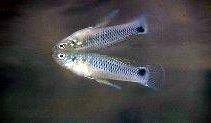
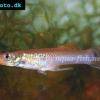 Pike
Pike 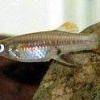 Biskop-tandkarpe
Biskop-tandkarpe 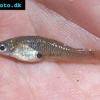 Mosquito
Mosquito  South
South 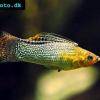 Sailfin
Sailfin 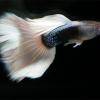 Guppy
Guppy  Short
Short  Endler’s
Endler’s 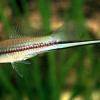 Swordtail
Swordtail 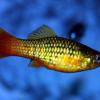 Platy
Platy 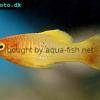 Variegated
Variegated